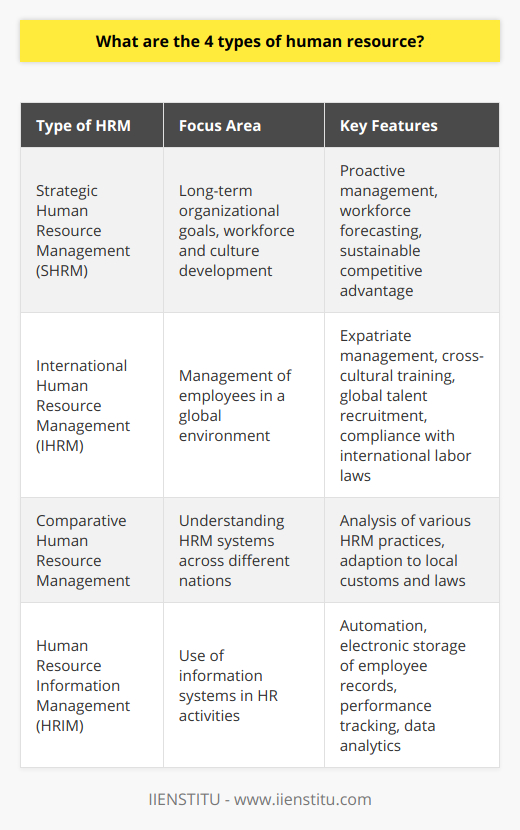
Human resources is a crucial element in any business or organization. Human resources are responsible for managing employee records, benefits, and payroll. Additionally, human resources also handle employee relations, training, and development. Let's take a more in-depth look at each branch of human resources.
What is the role of HR in today's business world?
Human Resources is a vital part of any business, and its role has changed dramatically in recent years. HR departments are no longer relegated to simply handling payroll and healthcare; rather, they are now strategic partners in assisting companies in achieving their objectives.
This shift has required HR professionals to learn about various topics, from employment law to marketing. To stay competitive, businesses need to ensure they have the right people to manage their HR Functions effectively.
This blog post will discuss the different branches of Human Resources and what they entail. We will also explore the importance of HR in today's business world. Stay tuned!
1 - Human resources management
Human resources management is managing the people who work for an organization. Human Resources branches include recruiting, hiring, training, and managing employee benefits. Human resources managers are responsible for ensuring that the right people have been placed in appropriate positions.
To do this, human resources managers must have a good understanding of the organization's business goals and its employees' needs. By aligning these two areas, human resources managers can play a vital role in helping an organization achieve its goals.
2 - Employee relations
Employee relations is one of the many branches of human resources. It is responsible for managing the relationship between an organization and its employees. This includes dealing with employee discipline, grievances, and unions. Employee relations are a crucial part of any organization, as it helps to create a positive and productive work environment.
To be successful, employee relations must be based on trust, respect, and communication. Organizations can improve morale, motivation, and productivity by fostering a positive relationship with employees.
3 - Training and development
Training and development are essential for the success of any organization. By investing in employees' professional development, businesses can ensure that they have a skilled and knowledgeable workforce. Training and development also help to Improve Employee Morale and motivation, as well as reduce turnover rates. There are many different training and development programs, but all should be designed to meet the organization's specific needs.
Formal programs can include classroom-based instruction, online courses, or on-the-job training. Informal programs might involve mentorship or coaching from more experienced employees. No matter their form, practical training and development programs are essential to any successful business. Human Resources branches typically manage training and development activities, including Training Departments, Organizational Development Departments, and Employee Relations Departments.
4 - Compensation and benefits
A company's human resources department is responsible for several different things, one of which is compensation and benefits. This branch is charged with designing and administering programs that provide financial and other rewards to employees in exchange for their work. This includes salaries and bonuses to health insurance and retirement plans.
Companies must offer competitive compensation and benefits packages to attract and retain the best talent. Doing so can ensure that their employees are happy, engaged, and productive.
5 - Labor relations
Human resources are responsible for a wide range of functions within an organization, from recruitment and training to benefits and payroll. One of the essential branches of HR is labor relations. Labor relations specialists manage the relationship between an organization and its unionized employees. This includes negotiating contracts, resolving disputes, and administering collective bargaining agreements.
Labor relations aim to create a positive and productive working environment for all employees. By working closely with management and unions, labor relations specialists can help ensure that everyone's needs are met. Moreover, in today's increasingly competitive business environment, effective labor relations are essential for any organization that wants to succeed.
6 - Safety and health
Safety and health are important parts of any organization's Human Resources department. The goal of the safety and health program is to prevent injuries and illnesses in the workplace. This is accomplished by developing safety policies, conducting safety audits, and investigating accidents.
The safety and health program is also responsible for training employees on how to perform their job duties safely. As a result, organizations can create a productive and positive work environment by ensuring that employees are safe and healthy.
7 - Employee assistance programs
Employee assistance programs are just one of the many services branches of Human Resources offers. These programs are designed to help employees deal with personal problems affecting their work performance. This can include counseling, financial planning, and child care assistance. As a result, businesses can create a more positive and productive work environment by offering these services.
In addition, employees who enroll in these services are often found to be more able to tackle anxiety and maintain a healthy work-life balance.. As a result, companies that offer employee assistance programs often see improved employee satisfaction and retention rates.
8 - Organizational development
Organizational development is a field of research that covers a wide range of topics, including the study of organizational behavior, organizational change, and leadership. It also encompasses the areas of human resources and management. The goal of organizational development is to improve the effectiveness of organizations by making changes to their structure, culture, or processes. Often, this involves the implementation of new technologies or the streamlining of operations.
Related Course: Leadership Development Course
Organizational development can also help employees' working conditions and make them more efficient, and it's a must for those interested in Human Resources. Organizational development is a complex field of study, but its goals are simple: to make organizations more effective and efficient.
Organizations are constantly changing and evolving, and businesses must stay up-to-date with the latest changes to remain competitive. By understanding how organizations work, companies can adapt their practices to be more effective. Therefore, organizational development is essential for businesses that want to stay ahead of the curve.
Human resources is a complex field that requires expertise in various areas. Administration, employee relations, and training and development are just a few branches of human resources. Each unit has its unique set of responsibilities that contribute to the overall success of the company or organization.
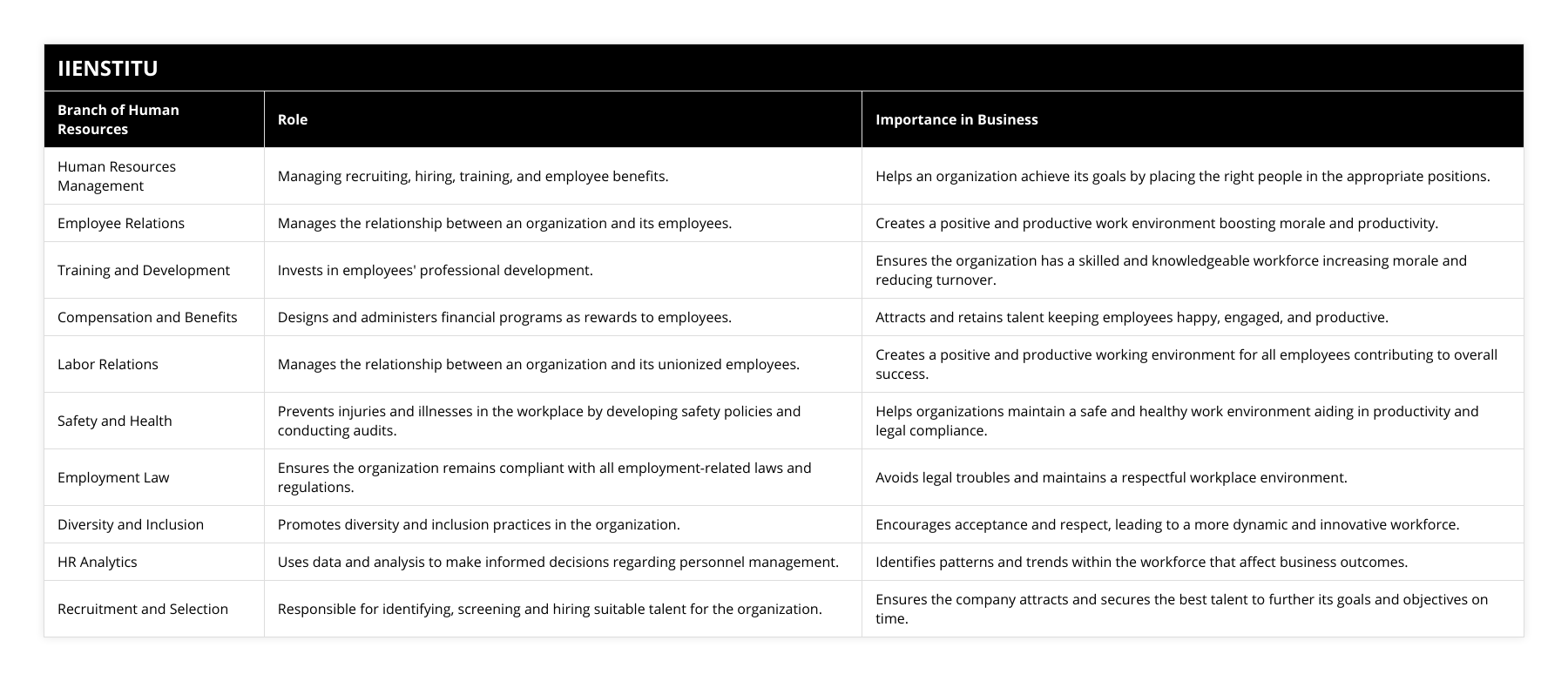
Frequently Asked Questions
What are the different branches of human resources?
There are several branches of human resources, which can be generally divided into two categories: functional and operational.
Functional branches include staffing, training and development, compensation and benefits, and labor relations. These are the areas that focus on the management and administration of HR programs.
Operational branches include recruitment, selection, placement, and induction. These are the areas responsible for attracting qualified candidates and bringing them on board in an organization.
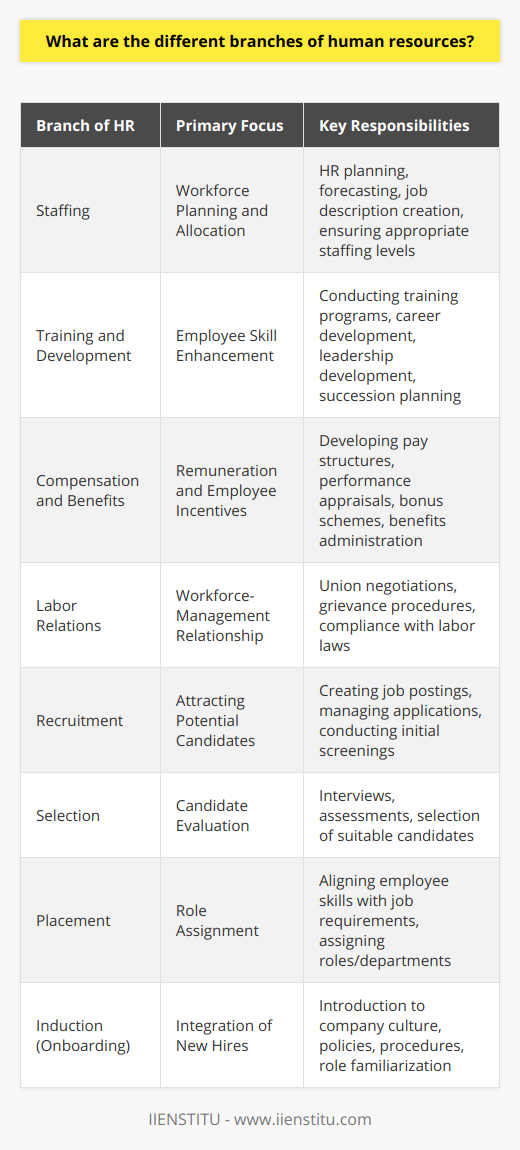
What is the role of a human resources manager?
The role of a human resources manager can vary depending on the organization, but generally they are responsible for overseeing all aspects of the employee experience, from recruiting and onboarding to maintaining employee records and conducting performance reviews. They may also be responsible for developing policies and procedures related to HR, such as compensation and benefits.

How do you become a human resources specialist?
A human resources specialist typically needs a bachelor's degree in human resources, business, psychology, or a related field. However, some employers may accept applicants with associate's degrees or relevant work experience.
Human resources specialists must have strong communication and problem-solving skills. They must also be able to maintain confidential information. In addition, they should be familiar with state and federal employment laws.
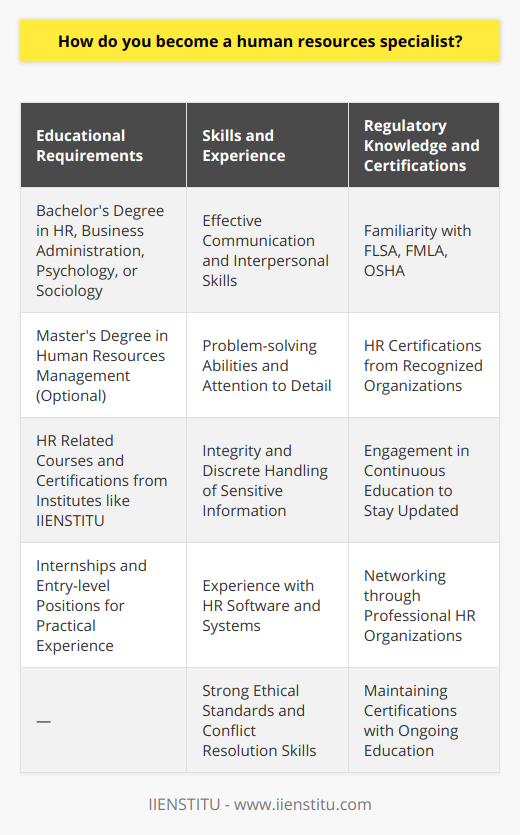
What are the 5 branches of HR?
Organizational Management and HR Development
The vast field of Human Resources (HR) breaks down into several branches. One crucial branch is Organizational Management. It orchestrates the overall structure of a company for efficiency. Another is Human Resource Development, tasked with enhancing skills through training and professional growth initiatives.
Recruitment and Compensation Management
The branch of Recruitment is also essential. It's responsible for attracting, selecting, and appointing suitable candidates to fill job vacancies. Equally essential is Compensation Management, which designs and manages the compensation packages. This branch ensures fairness and competitiveness in salaries, benefits, and bonuses.
Employee and Labor Relations
Finally, the branch of Employee and Labor Relations handles issues arising from managerial interactions with unionized and non-unionized employees. It aims to keep a harmonious working atmosphere. Moreover, this branch ensures adherence to labor laws and regulations. In conclusion, these five branches of HR contribute to creating a conducive, productive, and satisfied working environment.
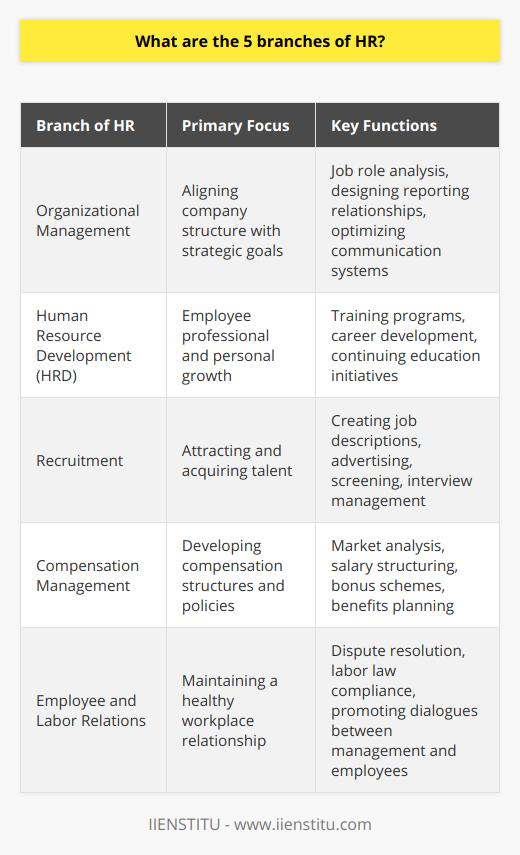
What are the 7 types of human resources?
Human Resource Types
Recruiting Team:
Recruiting teams look for potential candidates. They hunt down talent to fill open roles. This group manages the initial employee screening process.
Training and Development:
This sect focuses on employee growth. It aims to increase the quality of work. This department is in charge of identifying employees' needs and providing ongoing training.
Compensation and Benefits:
Compensation and benefits professionals ensure fair remuneration. They design and oversee salary and benefits packages. This keeps the workforce motivated and content.
Employee Relations:
These experts maintain healthy employer-employee relations. They ensure the working environment is conducive for everyone. They settle conflicts and take care of employee morale.
Compliance and Safety:
This team ensures the company adheres to employment laws. They're also responsible for employee safety at the workplace. They protect companies from legal troubles, ensuring conformation to rules.
Labor Relations:
Labor relations specialists negotiate with unions. They deal with collective bargaining agreements. They handle issues like strikes, work stoppages and grievances.
HR Information Systems (HRIS) Analysts:
They manage the systems that store employee data. This team aids in making informed business decisions. They manage efforts to improve HR efficiency through technology.
These seven types build the Human Resource structure. They work together to manage the workforce effectively. A fluid collaboration across these departments aids in establishing a pleasing work environment, thus enhancing productivity.
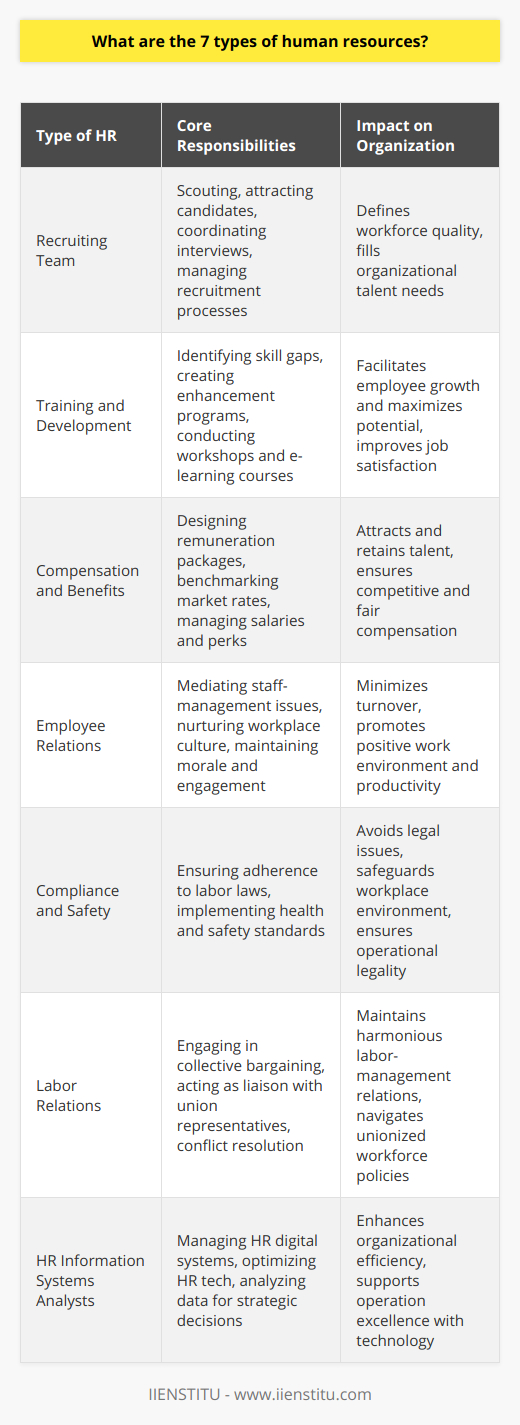
What are the 4 types of human resource?
Human Resource Management Types
Strategic Human Resource Management
Strategic human resource management concerns strategic decisions for the long-term success of an organization. It aligns the organization's human resources strategies with its mission, vision, and business goals.
International Human Resource Management
International human resource management focuses on managing the diverse cultural, economic, and legal aspects of managing employees in international businesses. It involves process considerations for recruiting, selecting, training, compensating, and managing the performance of employees working in different countries.
Comparative Human Resource Management
Comparative human resource management involves studying and comparing HR practices in different countries. It considers cultural nuances, business practices, and differing labor laws. Such a comparison assists firms in understanding best practices which they can adopt.
Human Resource Information Management
Human Resource Information Management is technology-driven. It integrates human resources with information technology through HR software. It simplifies and automates various tasks, storing and managing vital employee records, policy information, employment laws, and payroll and benefits data.
Each type of human resource management plays a vital role in managing people within organizations. Understanding these types can equip businesses to tackle various HR challenges effectively.
